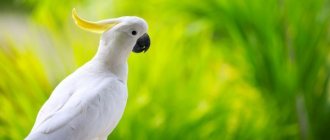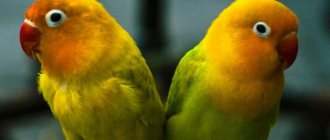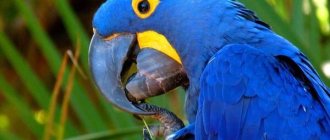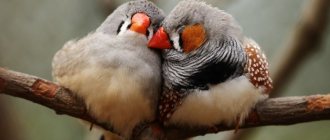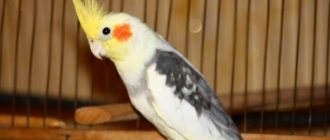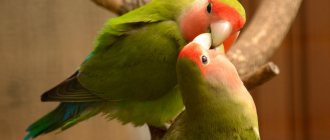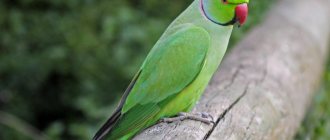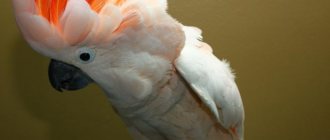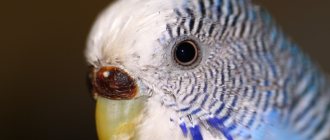The Corella parrot is perfect for home breeding. Beginning breeders are interested in all the nuances of keeping them: what to feed, where to place them, how to treat these good-natured birds. Against the background of everyday issues, a special moment stands out: how long do cockatiels live, because a feathered pet can become a true friend.
How long does a cockatiel live in the wild?
In its homeland, the Australian continent, the bird lives in luxurious conditions: warm air and plenty of water in the rivers, the freedom of endless open spaces, a variety of trees and shrubs. The flock does not stay in one place; it flies over long distances in search of food.
You might think that nothing threatens birds in their natural habitat, but this is not so. Their good-natured nature and need for communication sometimes plays a cruel joke on them, and the birds fall into the hands of hunters who catch them for sale or consumption. In addition to people, the length of a cockatiel’s free life is influenced by environmental conditions: periods of drought, forest fires. These parrots do not fly quickly, and many of them die when attacked by predators. According to ornithologists, cockatiels in the wild live a little more than ten years, constantly being exposed to danger.
Features of keeping Corella parrots boy and girl
When purchasing a mixed-sex pair, it is important to understand that this will eventually lead to the appearance of chicks. Therefore, first you need to properly equip the place where the parrots are kept.
First, you need to purchase not an ordinary cage, but a so-called cage, which has a flat roof and a hole on one of the walls, except the front one, so that when the time comes to hang the nesting device.
In the nymphs' home, the length of the cage should be twice as wide as the width, so that when flying from perch to perch, muscles are strengthened and metabolism is improved, which will have a positive effect on the health of the offspring.
A mixed-sex pair of cockatiels will quickly have offspring
Life expectancy of a cockatiel at home
Since the health and lifestyle of a tamed bird is largely influenced by human care and concern, it depends only on the owner how many years a cockatiel parrot lives at home. In captivity, he reaches an average age of 16-18 years, but under favorable circumstances and proper care he can die of old age only at 25 years.
Why does the female live less than the male?
The lifespan of a male cockatiel parrot is longer than that of a female. And this is explained by physiological differences, because females lay eggs, which greatly wears out the bird’s small body. Reproduction in the natural habitat occurs during the rainy season, when there is enough food. It is advisable for tame individuals to rest for six months or a year between periods of the appearance of offspring.
In one clutch there are from five to seven eggs, which are incubated by both parents. At the end of the incubation period (21-23 days), chicks appear. How long mom and dad will feed them depends on their readiness for a new clutch, but more often it lasts a couple of months. If a female breeds offspring more than once a year, she is not destined to become a long-liver.
Who has a longer lifespan: a male or a female?
The male cockatiel differs from the female in having a longer life. This is due to the physiology of birds. Female cockatiels spend a large amount of energy when incubating and feeding their chicks.
Cockatiel chicks
After about 6 weeks, the chicks become stronger and are ready for independent life. The female is again ready to mate and raise offspring. This greatly affects her health. Females in captivity live no longer than 8 years.
Males are resistant to stress. It is easier for them to endure unfavorable conditions. Again, there are no additional stressors associated with offspring. The average lifespan of male cockatiels is not 12 years.
Factors influencing life expectancy
Birds living near humans do not need to worry about food and fear attacks from predators. If you are puzzled by the question of how many years your cockatiel will live carefree, think about whether you can create favorable living conditions for it. Do you have free time to communicate with your pets, do you have the patience to care for them and hear constant chatter, is there enough space in your apartment to install a large cage. There are other difficulties in properly keeping cockatiels that affect the length and quality of their life.
Cell
Adult cockatiels reach a size of 30-33 cm, so for comfortable movement they need a spacious steel frame or a rectangular enclosure with a high metal or plastic tray. The parameters of the home must be at least 100/40/50 cm. The interior must be diversified with devices for feeding and interesting activities:
- retractable feeder;
- vacuum automatic drinker;
- wooden perches;
- plastic bathtub;
- ladder and swing;
- bells, balls;
- mirror.
How many toys there will be depends on your desire and capabilities. Feathered friends will be delighted with everything that is offered to them. An important note about choosing a location for the cage: it is recommended to install it in the room where you will most often be and talk with your pets. When cockatiels live at home, they are limited in their flights and do not have the opportunity to communicate with their flock mates; silence depresses them and leads to depression.
Proper nutrition
A well-chosen diet greatly affects the appearance, mood and reproduction of the cockatiel, and how long these birds live in a healthy state is determined by the quality of the food. In order to prevent vitamin deficiency or any disease, you need to regularly supply your parrots with plant and animal food, and do not forget about vitamin complexes. The daily norm of minerals is present in grain feed and products of animal origin, so cockatiels do not need additional feeding with micro and macroelements.
Microclimate
Sunlight is very important for birds, but not direct rays, but scattered ones. Vitamin D, which is produced in the body under the influence of ultraviolet radiation, largely determines how long the cockatiel parrot lives.
Important! In the winter season, when daylight is short, at a distance of one and a half meters from the cage you need to turn on a regular electric lamp, or even better, an ultraviolet lamp.
Sudden temperature changes and drafts should not be allowed. Birds love to swim and, once wet, will freeze and catch a cold. The optimal temperature for cockatiels in an apartment is 18-20 degrees, the relative humidity should be from 70 to 80 percent.
Stress
Cockatiels have a highly developed nervous system and react acutely to stimuli. Some situations can unbalance and even affect the duration of a calm life of a cockatiel parrot. Stress can be caused by reasons such as:
- loud sharp sounds;
- sudden flash of light;
- change in diet;
- starvation;
- unsuitable microclimate;
- crowdedness;
- lack of proper sleep and rest;
- inability to hide in a corner;
- rough catch.
Transportation can be very frightening for a cockatiel, especially if it is transported in a large cage: the bird runs the risk of falling from the perch and being injured. The first time after delivering the bird to its new place of residence, you should carefully monitor its behavior. In a state of stress, a bird’s growth and development slows down, and food digestibility deteriorates.
Do cockatiels speak and how to teach a cockatiel parrot to speak and sing songs?
As the heroine of Liya Akhidzhakova said in “Office Romance,” “you can teach a hare to smoke,” but teaching a smart cockatiel to talk is even easier.
The main thing is to start as early as possible and not buy a pair for him, because then they will talk to each other “in their own language.”
To make a cockatiel talk, you can't buy him a pair.
First you need to let the bird get used to the owner and his hands, while talking to her all the time. There should be only one teacher, so you need to include 40-45 minutes of daily training in your schedule, possibly with breaks.
Corella needs to get used to his owner's hands
Classes should take place in a calm environment where there are no extraneous sounds. The pet must be in a cage during lessons.
You need to start with simple phrases, such as “Kesha is good”, “Kesha is beautiful”, “Hello”, “How are you”. The abundance of sonorant and sibilant consonants, as well as the vowels “a” and “o” makes the task easier, because it is easier for the parrot to pronounce them.
The phrase must be constantly repeated, addressing the pet directly, until the result is achieved.
Before speaking, the cockatiel listens carefully to the words of the owner
Intonation should not change when repeated many times. You can constantly accompany the actions performed by the parrot with comments, such as “ Kesha is eating”, “Kesha is bathing” , then the conversation will seem meaningful. After moving on to the next phrase, you need to regularly repeat what you have already learned.
To make your parrot sing, you can record songs on a disc and let him listen to them several times a day. This will soon bear fruit and the cockatiel will give small concerts.
Cockatiels are happy to make contact and learn poems and songs with their owner
Causes of early death
In captivity, cockatiels die as a result of the wrong attitude of the owner. It must be remembered that a living, defenseless creature must be carefully looked after and protected when threatening situations arise. The most common manifestations of human negligence, which significantly reduce the life expectancy of domestic cockatiels:
- forgot the cage on the window on a hot day;
- intensively ventilated the room;
- crushed during capture;
- were not supervised during the walk;
- they did not hide the medicine, poisoning occurred;
- did not communicate with the pet, drove him to depression.
Like all living things, cockatiels are very susceptible to various diseases. It is imperative to consult a veterinarian if the bird is sad or its behavior is causing concern. How many years a cheerful bird will please you depends on your care. If you liked the article or have something to add, then leave your comments and also join our VKontakte group.
How to name cockatiels, how to come up with names?
If you plan to find an interlocutor in a parrot in the future, then his name should be short, laconic, contain hissing sounds and a sonorant “r”: Kesha, Gosha, Petrusha, Bisha, Shura, Rashik, Lusha, Krosh, Glasha .
If there are problems determining gender, then the nickname should be “unisex”: Chucha, Eshka, Roni .
Also, the chosen name should not be similar to the names of other pets or family members.
You can choose a name taking into account the character traits and demeanor of your feathered friend: Shurshik, Lucky, Sheiki .
Corella parrot loves to say its name
Details and subtleties of handling
In order for your pet nymph to be healthy, playful and funny, it is important to handle it correctly. For example, it is not recommended to catch a parrot with your hands, because this greatly frightens the bird and then makes it more difficult to gain its trust.
The best way is to open the cage and wait until the bird flies into it to eat, rest or sleep. You should not try to remove the parrot from its cage against its will.
It is very important to develop a close relationship with your Corella parrot, spend more time near the cage, and it is strictly forbidden to frighten him with knocks and sudden movements.
Species (subspecies)
Photo of a light gray cockatiel
The only species of cockatiel that lives in natural conditions has a light gray or dirty gray color. But thanks to breeders, new varieties of nymphs of different colors were bred in captivity. Currently, there are eleven main color variations of cockatiels, and some even have their own subspecies.
Albino Corella
Photo of an albino cockatiel.
A distinctive feature of this species is the white color of the plumage of the female and male and red eyes. A slight creamy coating is allowed, but the yellow color of the head feathers and crest is retained.
Males always have snow-white feathers, but females may have slightly yellowish spots on the wings and under the tail, which create a marbled effect.
To produce albinos, breeders crossed lutino with parrots that have a white head.
The albino cockatiel subspecies includes the white nymph, which has black eyes and a clearly visible yellow coating on its plumage. Interestingly, the two longest tail feathers in males are snow-white in color, while the rest remain slightly yellowish. In females, the tail is yellow and the undertail is marbled. When obtaining this subspecies, they were used to cross white females and gray males, who are carriers of the whiteness gene.
Lyutino
Photo of Corella Lutino
Corella Lutino is characterized by red eyes and deep yellow feathers. In adults, the eye color changes to dark cherry. There is spotting on the wings and back, but the color contains only various shades of yellow, which determines the name of the species.
On the light yellow plumage of the dewlap there is a kind of ladder of more clearly visible spots. This is considered a disadvantage of the breed, so breeders are looking for crossbreeding variations that will make it possible to get rid of it.
In male lutinos, the “blush” on the cheeks must be orange.
Sheki
Photo of Sheki cockatiel
Sheki are the most popular and expensive varieties of cockatiels. They are distinguished from other species by the presence of white spots on gray feathers. The symmetrical arrangement of spots, as well as the presence of gray and white in equal proportions, are especially appreciated.
Sheki have gained great popularity among breeders, as they are recognized as the best source material for breeding new subspecies. An example of this breeding is the Pearl Neck, which has an all-white head, a yellowish-tinged tail, and iridescent gray feathers on the back and wings. Interestingly, in adult females the color remains even after molting, while in adult males the color changes to the classic shek.
Among this subspecies of nymphs there are “harlequins” with gray wings, a yellow head and crest feathers. The rest of the body, neck and legs are white.
Cinnamon colored cockatiel
Photo of a cockatiel with a brown tint.
In the body of parrots, under the influence of enzymes, a black pigment is formed. Due to the failure of biochemical processes, the cinnamon-colored nymph produces more of these enzymes than the gray-colored cockatiel. As a result of crossing them with lutino, individuals with varying degrees of intensity of brown color are obtained.
From birth to 3 months, the eye color of the chicks remains red and then darkens. In adult birds, the beak and pink feet also gradually become darker.
In addition to the varieties described, the following subspecies of nymphs are distinguished:
- black;
Photo of black cockatiel
- light and pearl gray;
Photo of a light gray cockatiel
- dark yellow;
Photo of dark yellow cockatiels
- white- and black-winged.
Photo of a white-winged cockatiel
Bird diseases
It is quite natural that life expectancy is affected by various diseases. Fortunately, parrots are in good health and rarely get sick. In any case, it is worth remembering that you need to start fighting before the disease appears. It is worth observing all conditions of detention recommended by experienced ornithologists.
Signs of the disease may include if your pet:
- becomes lethargic, practically does not fly, spends the entire day on a perch;
- he just sleeps all day;
- stopped rejoicing at your appearance, abandoned his toys;
- does not clean his wings;
- bird droppings become liquid and have a strong smell;
- the pupil constantly sneezes;
- wet discharge appears from the beak;
- The bird's movements are uncertain, coordination in space is lost.
In any of the described cases, contact your veterinarian, only he can draw up the correct treatment plan.
Diet
The cockatiel menu should be as close to natural as possible. This means that the diet should be dominated by:
Grain feed (millet, hemp seed, oats, corn, canary grass). The average rate of grain feed is 1.5-2 tablespoons daily. The last number is for a large parrot.
Vegetables (cucumbers, carrots, Brussels sprouts).
Fruits (Plums, apples, peaches, pears, cherry plums). The parrot is partial to these fruits.
In small quantities, you can add wheat grains, sunflower seeds, nuts and legumes soaked in water. Sometimes you can gradually give animal products - boiled eggs and low-fat cottage cheese. Birds especially need animal protein during nesting.
Prohibited Products
The list of foods that cockatiels should not eat includes:
- Candied fruits.
- Seeds of stone fruit crops.
- Hot peppers.
- Milk, cheese, butter, sour cream.
- Spices.
- Potato.
- Mushrooms.
- Branches of conifers, oak, viburnum, pear, lilac, poplar.
- Sorrel and rhubarb.
Subtleties and nuances of care
The most important thing that the owner of a bird should never forget is its Australian origin, therefore care, care and warmth are the main components of its daily life, which the owner must provide.
The most optimal temperature for keeping a Corella parrot is approximately 20 degrees. If this figure is a little higher, that will also be good. And vice versa, if this temperature is lower, then it should be raised artificially, using a heater or a special lamp. But in such a situation, it is also necessary to take into account the air humidity in the room, on which the health and general good condition of the bird directly depends.
A sufficient amount of fresh air is another serious issue on which the health of the parrot depends. But here you should be careful that, along with fresh air, there are no dangerous drafts in the room that could seriously harm your pet.
Health
In general, this breed is not prone to diseases and is long-lived. Any diseases that occur in cockatiels are the result of neglect of the pet. Be attentive to the behavior of the bird, because it will not be able to tell you that it is not feeling well.
What health problems may exist:
- Feather loss.
- Feather and skin parasites.
- Violation of the structure of bones and beak.
- Infectious diseases.
- Disturbances in the gastrointestinal tract.
- Obesity.
- Amyotrophy.
- Avitaminosis.
Sound the alarm immediately and run to the clinic if the bird is already clearly sick. Most diseases are caused by poor or inappropriate nutrition and stress. Signs of health problems can be seen in behavior. The cockatiel becomes more aggressive, more active, or, on the contrary, very lethargic and constantly sleepy.
The pet may refuse any food or liquid. Check for breathing problems and any discharge from the nose, eyes or cloaca. Never treat a cockatiel yourself! Entrust examination and treatment only to a specialist!
Interesting Facts
Photo of a cockatiel on a cage
There are several interesting facts that colorfully characterize cockatiels:
- The nymph's intelligence is identical to the mental development of a 3-4 year old child.
- A parrot raised in captivity becomes completely tame, considering a person a member of its family.
- In the wild, a cockatiel sitting on the ground will not allow a person to approach it, but when it is on the branches of trees, it can safely allow people to touch it.
- Nymphs recognize about one and a half hundred different images per second, while humans recognize only 16.
- There are schools in Australia that teach cockatiels and other parrots to talk.
- Nymphs do not have vocal cords, and they produce sounds only with their mouths.
- Depending on which paw the cockatiel takes food with, it can be considered right-handed or left-handed.
